Catholic Customs
 |
 |
 |
 |
 |
 |
 |
Sacred Customs of Holy Thursday - IV
The Vigil of the Passion: Watching with Christ
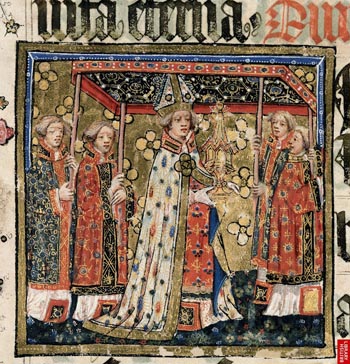
“Sing, my tongue, the mystery of the glorious Body and precious Blood!”
Thus begins that glorious hymn Pange, lingua gloriosi that honors Our Eucharistic Lord after the "Mass of the Lord's Supper" on Holy Thursday as Our Lord in the Blessed Sacrament is carried in procession to the Altar of Repose, a special tabernacle adorned with flowers, greenery and candles.
The priest or bishop then processes back to the main altar where he performs the ceremony of the Stripping of the Altars as a symbol of Our Lord’s Body stripped of His garments and a sign of mourning and respect for Our Lord's Passion.
The altars of repose
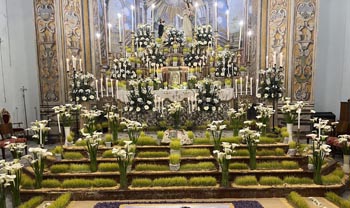
An Italian lavureddi with pots of sprouted wheat; below, a Spanish monumento or altar of repose
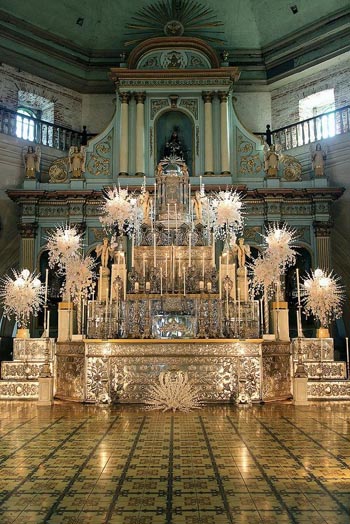
The Latin peoples of Europe and Latin America honor Our Lord with magnificent Altars of Repose. The altars, called monumentos, are created by erecting a many tiered platform representing a sacred hill that reaches nearly to the ceiling of the church.
Covering each tier of the monumento are hundreds of candles, lilies, orchids, palms and other flowers that offer a brilliant resting place for Our Lord in the Blessed Sacrament, who is placed reverently at the highest point. (2)
In the Italian cities of Trapani and Naples, the altars (lavureddi) are set up on tiered layers covered with white linen and adorned with burning candles in silver candlesticks, white flowers in vases, and wheat or lentil sprouts in pots. These pale sprouts have a symbolic connection with the Sepulchre, since they too were once buried in dark "tombs" of earth before they rose to new life. (3)
The night watch
"Could you not watch one hour with me?" (Mt 26:40)
This admonition is answered by the faithful children of the Church who have always spent this night adoring Our Lord in His Altar of Repose.
An old Roman custom, whose origin is often attributed to St. Philip Neri, is to visit during this night the Sette Chiese, or seven major basilicas: namely, St. Peter’s Basilica, St. Paul Outside the Walls, St. John Lateran, St. Mary Major, St. Sebastian’s, St. Lawrence Outside the Walls and the Basilica of the Holy Cross in Jerusalem.
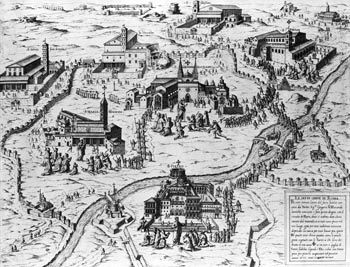
Visiting the Sette Chiese of Rome on Holy Thursday
In imitation of Rome, many city dwellers adopted the custom of visiting the Altar of Repose at seven (in some areas nine or 14) different churches during the night. (5) This pilgrimage was dutifully undertaken in Irish, American, Mexican, Spanish, Polish, Filipino and Italian cities. The pious custom is still observed in some areas, especially Italian cities, to this day.
Rich and poor alike went by foot on this pilgrimage, often reciting the Rosary as they walked. Indeed on Holy Thursday, in Madrid and Venice all carriages and vehicles were forbidden to pass through the streets to give the pilgrims free way of passage. So vehement were the people in this practice that in 1870 in Venice, when a free-thinking cabman drove up the Via Alcala, the people in the streets dragged him from his box, beat, kicked and cuffed him exclaiming, “Que bruto! He will wake our Jesus.” (6)
As Mexicans visited the seven churches, they received a small piece of bread from each of the seven parish priests. Taking their bread, they gave alms to the church by leaving a coin in the bread basket. (6)
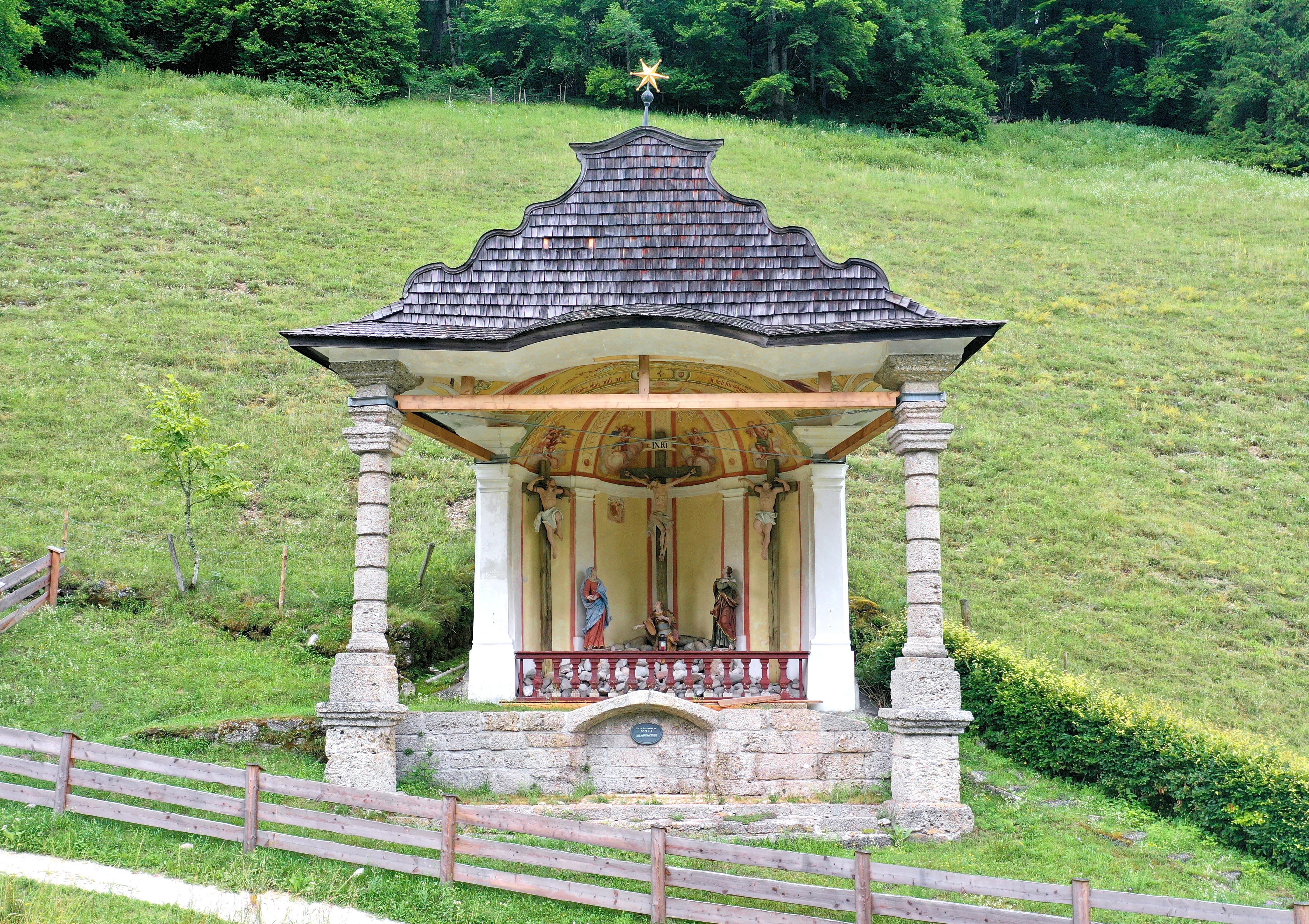
A Calvary Chapel in Austria; below, German peasants processing to a countryside Calvary Chapel
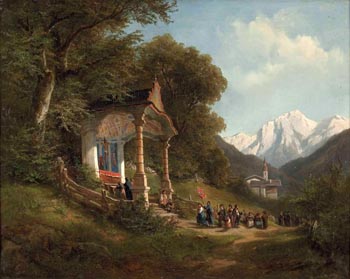
We beg you, people, hear and hark!
It's nine o'clock, and fully dark.
O, think of the pain which Christ has felt,
When, praying for us, in the garden He knelt.
Other such verses were sung at each hour of this sacred night. (7)
During the Counter-Reformation, the Jesuits strove to strengthen the faith of Catholics by founding Confraternities that promoted magnificent artwork and architecture, especially in the building of Calvary Chapels.
The first of these chapels to be built in the Salzkammergut region of Austria was in the town of Traunkirchen. The people went on a pilgrimage to this chapel every year on the night of Holy Thursday with a ceremony called Antlaßsingen.
Antlaßsingen began as villagers assembled in answer to the call of the night watchman. The lead singer then called out that the hour of Our Lord's betrayal and capture was at hand. The assembled villagers responded by singing the appropriate verse of a traditional song believed that came from the medieval Passion Plays.
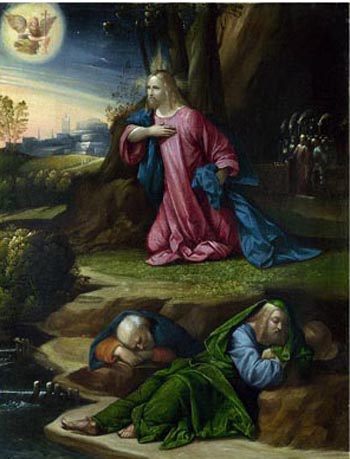
‘Could you not watch an hour with Me?’
Then, the people processed to the Calvary Chapel where the Antlaßsingen formally ended with the commemoration of the descent from Calvary at almost five in the morning as dawn began to shed its rays through the chapel. (8)
The Greeks too shared in the sufferings of Our Lord's Passion with great fervor. As dusk approached, Greek Catholics assembled at their churches to attend an all night vigil that began with a ceremony in which the priests read 12 Gospel passages relating to Our Lord's Passion.
After the fifth Gospel passage describing the Crucifixion, the priest carried a large crucifix into the middle of the church and attached lighted candles to the top and the two side arms of the cross. In loving devotion, the people adorned the cross with flower wreaths, and many of the faithful remained in the church where they sang mournful hymns compassionating the sorrows of Our Lord and His Blessed Mother. (9)
Preludes to the grand Passion processions of Southern Europe began this evening. In Sicily, each guild of the city made a float with life sized figures depicting an event in the Passion. On Holy Thursday night, these floats were paraded through the city, each float led by a band and followed by a group of guild members who poignantly described the scene of their float to the onlookers at specified stops on the route.
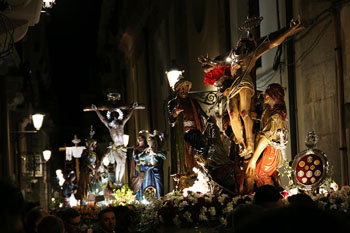
A lifesize figures of the Crucifixion in Sicily; below, Nazarenos or penitentes, with their crosses
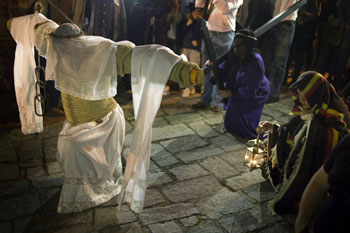
In the Spanish city of Valverde de la Vera, penitents process barefoot through the streets after dark on Holy Thursday with their arms extended and tied to a small tree trunk that stretches across their backs in a procession known as El Empalao (the Impaled). The penitents wear a crown of thorns and a white veil and carry two crossed sabers on their back as they slowly process through the streets following a path of the Stations of the Cross. A family member carries an oil lamp to light the penitent’s way. (10)
The fervor that inspired all of Christendom to courageously watch with Our Lord during the night of His greatest agony should encourage us living in these Latter Times to increase our zeal and restore those practices to make reparation to Our Lord and defend His honor against His enemies who are so bold as to blaspheme and insult Him even inside His Church.
Let us show to the world that “Christ conquers, Christ reigns, Christ commands.”
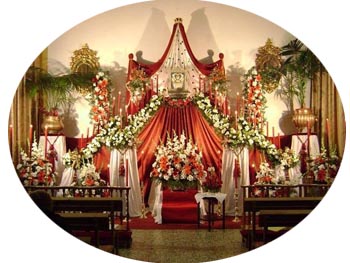
An altar of repose
- William Howitt, The Rural and Domestic Life of Germany (London: Longman, Brown, Green, and Longmans, 1842), p. 373.
- Francis X Weiser, The Easter Book (San Diego, California: The Firefly Press, 1996), p. 64.
- Carol Field, Celebrating Italy (New York: William Morrow and Company, 1990), pp. 410-411.
- https://www.catholicculture.org/commentary/traditions-holy-thursday/
- William S. Walsh, Curiosities of Popular Customs and of Rites, Ceremonies, Observances, and Miscellaneous Antiquities (Philadelphia: J. B. Lippincott Company, 1898), p. 677-678.
- Ann Ball, Catholic Traditions in Cooking (Huntington, Indiana: Our Sunday Visitor, 1993), p. 54.
- Weiser, The Easter Book, p. 66.
- http://www.brauchtumskalender.at/brauch-144-antlasssingen
- George A. Megas, Greek Calendar Customs (Athens: B. and M. Rhodis, 1963), pp. 96-97.
- Cristina Garcia Rodero, Festivals and Rituals of Spain (New York: Harry N. Abrams Inc, 1994), p. 278.

Posted March 20, 2024
______________________
______________________
 |
 |
 |
 |
 |
 |


